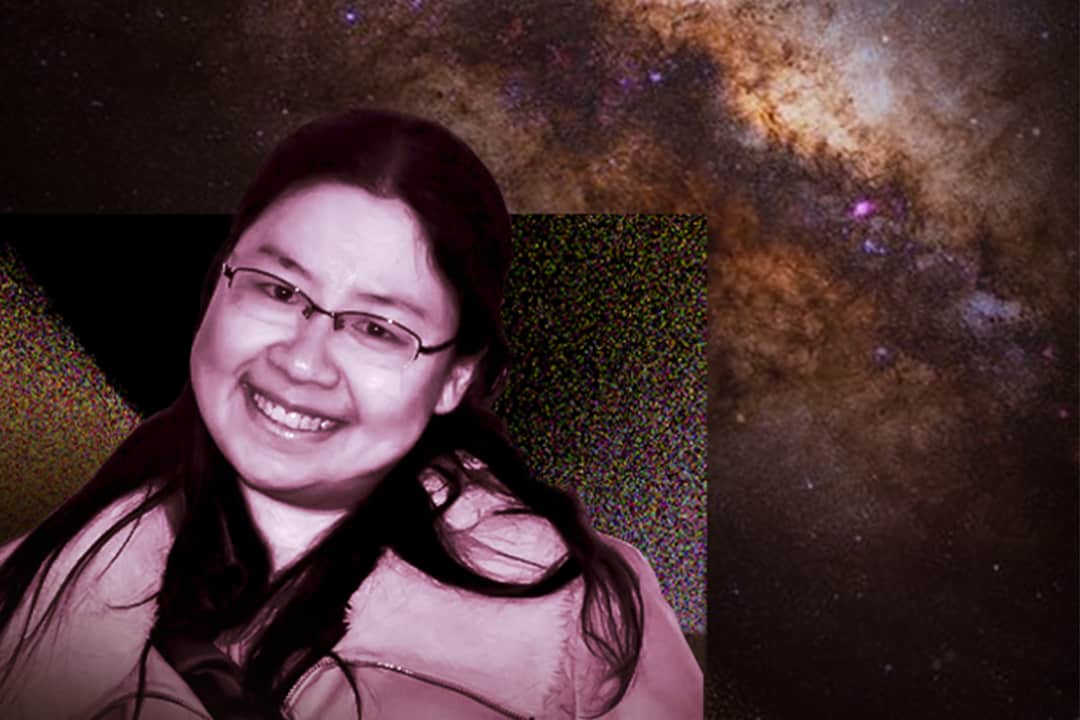On the morning of November 24, Assistant Professor Ting Li at U of T’s Department of Astronomy and Astrophysics was awarded the 2023 Dorothy Shoichet Women Faculty in Science Award of Excellence. Later that evening, she gave a Star Talk, a series hosted by U of T’s Astronomy & Space Exploration Association, titled “Navigating Stellar Streams: Unveiling the Milky Way’s Hidden Secrets.”
I was nervous being in that lecture hall. I hadn’t been to an astrophysics lecture in six years. Luckily, the talk was approachable to those without a physics background.
Seeing dark matter in the Milky Way
Large images and graphs accompanied Li’s talk. One was a simulated density map of dark matter in the Milky Way, which is a spiral galaxy, or a massive collection of stars, dust, and gas in the form of a spinning pinwheel. In general, density maps are maps of a region in the sky where lighter areas of the region indicate high clusters, or a high density of whatever matter scientists are measuring, and darker areas indicate sparser matter in a given region.
Dark matter, according to NASA, is an unknown matter that makes up about 27 per cent of our universe and is not visible or normal matter. Dark matter has mass that can bend the light travelling from galaxies behind it. The degree to which this mass bends the light helps astronomers create density maps of dark matter.
On the other hand, a stellar density map of the Milky Way — where Earth resides — is a density map that would help configure the distribution of stars in the galaxy as well as the structure of our galaxy’s swirling arms.
And these density maps show a lot. Surrounding the disc of the Milky Way is a gigantic spherical halo shape of dark matter known as the main halo, and it is orbited by many smaller and more compact clusters of dark matter known as sub-halos. Sub-halos that are large enough and have enough gas can create stars and dwarf galaxies smaller than the Milky Way.
Dwarf galaxies like the Large and Small Magellanic Clouds can orbit the Milky Way as satellite galaxies. Satellite galaxies are essentially galaxies that orbit other galaxies, like planets orbiting the Sun.
If satellite galaxies get too close to the Milky Way, they can end up as ribbon-like structures called stellar streams. These streams are the remains of galaxies and star clusters that have been ripped apart due to the Milky Way’s gravitational pull and now exist as linear clusters of individual stars, called member stars.
Stellar streams and how to find them
The importance of stellar streams lies in their ability to answer questions about the mass and shape of the Milky Way. Stellar streams can help in understanding how much dark matter mass is in our galaxy and how it affects the Milky Way.
While nearly a third of the universe is made up of dark matter, most of the Milky Way is dark matter. Finding dark matter would help us understand the weight of the galaxy and that in turn would help answer cosmological questions, especially about the evolution of galaxies.
Li used the analogy of Christmas lights to demonstrate the role of stellar streams. Just like the shape of Christmas lights on a tree in the dark can provide an idea of what the tree looks like, stellar streams function as visible matter that can help us infer the mass distribution of the Milky Way.
Astronomers are using sky surveys to discover stellar streams. Using powerful cameras, they image the sky multiple times to look for data on stars, like their brightness and location. Stellar density maps, created by powerful cameras, are used to map member stars and then detect stellar streams.
Astronomers have known of the existence of stellar streams since 1994, and research on stellar streams has been rising dramatically for the last two decades due to emerging surveys. One reason for this sharp increase in discoveries is the advancement of giant telescopic cameras with diameters at least a metre wide. The specific camera Li mentioned was the Dark Energy Camera, part of a four-metre telescope located at the Cerro Tololo Inter-American Observatory in Chile.
Space satellites like Gaia and the Giant Magellan Telescope have also helped pave the way to discovering more stellar streams. Gaia is a spacecraft with the main mission to create a precise 3D map of more than a thousand million stars in our galaxy and beyond. According to the Smithsonian Astrophysical Observatory, the Giant Magellan Telescope is going to be the world’s largest and most powerful telescope and is to be operational by 2029.
The takeaway
I realized I had been leaning over the desk for the entire lecture. I stuck around to sit down with Professor Li, who told me that there is beauty in discovering something you never meant to.
Awe had replaced my nerves by then. I had stumbled upon a whole world I didn’t know about, which included discoveries, people, and entire entities that are much more than meets the eye.



No comments to display.